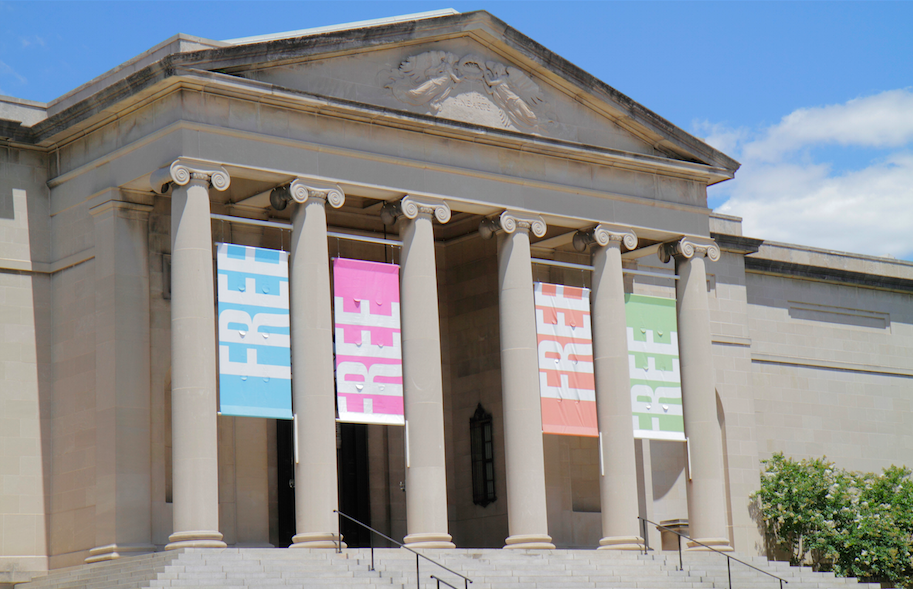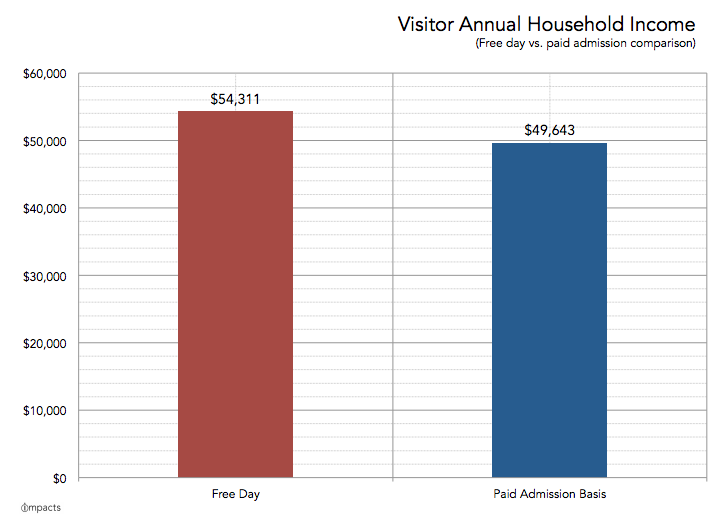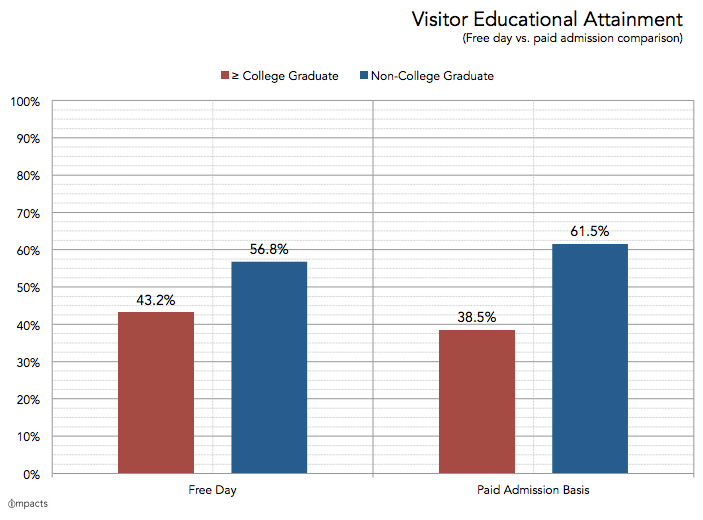In reality, free days often do the very opposite of mission work. Here’s the data.
This post is going to make people angry. And that’s a good thing. Get angry. Being challenged helps us think critically and evolve our strategies to more effectively serve our missions and audiences.
I made some folks angry when I shared data and pointed out the compelling economic research behind why free admission is not a cure-all for getting folks to visit cultural organizations. How much does free admission really affect attendance? Turns out, not all that much. I’ve also pointed out that admission pricing is a science (not an art), and how admission pricing is such an emotional topic for cultural organizations is because we confuse admission with affordable access programming. As a sector, we cultural organizations often really mess that up.
Today I’d like to share another data-based finding that should turn our traditional business strategies upside down: Free admission days do not usually engage affordable access audiences. In fact, data suggest that free days often accomplish the very opposite of their intended purpose for many cultural organizations.
Here are four, data-informed realities regarding free days for cultural organizations. (This includes museums, aquariums, zoos, theaters, symphonies, historic sites, etc.) It’s time to face some realities and put on our collective thinking caps…
1) Admission price is not usually the primary barrier to visitation
When contemplating a free program or event, many organizations mistakenly believe that, “If we build it, they will come.” It is a line from a great movie, but it’s an ineffective business practice. Admission price usually isn’t the primary barrier to engagement for non-visiting audiences. It just happens to be our most convenient excuse.
True primary barriers for non-visiting audiences usually revolve around other factors than simply cost. These often include things like reputation (i.e. they just aren’t interested in the content and programs), transportation and parking (“How are we going to get everyone together and get there?”), or schedule (“That’s awesome that you have a free day on Tuesday. I have to work on Tuesday.”) When the primary barrier to visitation is anything other than admission price, then having a free day becomes relatively irrelevant. An admission fee is straightforward, but for many potential visitors, other barriers are the most challenging part of the visitation equation.
When we think that making something free means that everyone will come, then we are assuming that visiting us is the most important thing in every potential visitor’s life after cost savings. We all know that’s not true… and, somehow, we still resist thinking critically about primary barriers to entry. We aren’t taking the time to do the necessary market research that enables us to be more responsive to audience needs. Sometimes admission really is a big barrier to entry. Yes – money is precious. Many organizations seem to know this. But time is precious, too. Too many organizations seem to forget this.
2) Free days attract higher earning and higher educated audiences than paid attendance days
This is a hard pill to swallow: For most organizations, data suggest that people who visit on free days actually have higher household incomes and educational attainment than people who visit on non-free days. For many organizations, free days are reaching a relatively small number of true affordable access audiences – and a whole heck of a lot of people who could pay to support your organization through regular admission or membership instead.
Check out this data from IMPACTS that is collected from 48 cultural organizations that offer regular, scheduled free days in an effort to reach affordable access audiences. The sample represents museums, performing arts organizations, and other visitor-serving organizations.
The common, defensive response to this data is to make an excuse and say that this data does not apply to your organization’s free days! Know this: Free days engaging higher earning households instead of affordable access audiences is the rule – not the exception. At IMPACTS, we are asked to supply this kind of information to many grant-making entities. So please, instead of making excuses, do your organization a favor and actually look into this situation. Increasingly, smart grant-making entities are catching onto these things and are aching to see programs that actually engage the targeted audience segments.
3) Free days engender less trial from new audiences than paid admission days
Why do folks visiting on free days have higher household income levels? One of the reasons is because data suggest that the folks actually attending free days are more likely to be repeat visitors than on paid attendance days- and repeat visitors often profile as higher-income high propensity visitors. The people who attend free days for cultural organizations have usually visited the organization before, and the free day is simply accelerating their pace of re-visitation.
“Great!” you may say. “We are getting folks to come back!” But now think about this: These people are coming back for free and they are higher earners who could have been converted into members. “Free” actually provides an incentive for your most likely and loyal audiences to visit you again. These are the very same people who – with proper cultivation – likely profile as potential members. Free days directly cannibalize membership opportunities and do not engender increased trial from underserved audiences.
You may notice a few audience members that you believe to represent your organization’s underserved audiences roaming your halls on a free day. But keep in mind, you’re likely looking for these types of people on these days. (There likely are some affordable access audience members- just fewer than there are on paid admission days.) Instead of offering proof of the efficacy of your initiative, these sightings are more likely a classic case of confirmation bias (i.e. the tendency to search for data that confirms one’s hopes or preconceptions). When considered in the relative context of total attendance, many free days don’t engage a higher percentage of first-time visitors than do non-free days.
4) Cultural organizations do not generally target affordable access audiences for free days
This fact is basic, overlooked, and often a driving reason for the last two conditions: A majority of organizations don’t even reach out to affordable access audiences regarding their free days. Instead, we tend to target high-propensity visitors- the people we know how to target.
Underserved audiences are not in your database. These audience members are not likely on your email list (they are underserved!), in direct mailings (you don’t know their names!), or following you on social media (they don’t visit you!). Many of them also may not be subscribers to the local newspaper (depending on the demographic subscribed to that newspaper). When we use our traditional communication channels to spread messages about free days, we are often primarily connecting with high-propensity visitors instead of underserved audiences.
But we don’t make affordable access promotions available primarily to upper middle-class, educated people because we’re stupid. We often use these channels because we don’t want to lose even more money. Reaching real affordable access audiences is a true investment. It often involves buying advertising that specifically targets those audiences who do not generally engage with your earned and social media programming. It occasionally requires creating programs that do not interest traditional audiences. It means spending money so that audiences who are not likely to provide any significant financial support can engage with your organization and not contribute admission revenue on top of it.
Many organizations may be relatively comfortable with the notion of needing to spend money to make money. But affordable access programs often require spending money to better achieve our missions… and lots more money than a loss of a day of revenue.
In a way, many organizations unknowingly do free days to feel better about themselves and their missions – not because they work.
This doesn’t mean that free days are always a bad idea. Sometimes the situation is complicated and that’s when having a free day could logically be on the table as a smart move. For instance, a government entity may request access for locals in order to provide significant support.
We will only create effective programs that reach underserved audiences when we realize that many past practices have been largely inadequate at achieving the very outcomes that they are created to achieve. The fact that underserved audiences exist at all means that, well, we haven’t been effectively engaging all of our potential audiences – even when we’re free.
Like this post? Here are a few related posts from Know Your Own Bone that you might also enjoy:
- Why It’s Okay if Your Nonprofit Hates Data (And Why You Need it Anyway)
- How Free Admission Really Affects Museum Attendance (DATA)
- How to Engage New And Diverse Audiences in Cultural Organizations (DATA)
- Devastating Defenses: Five Common Excuses Sabotaging Cultural Organizations (DATA)
Interested in getting blog posts, tips, and some silly social media geekery periodically delivered in your Facebook newsfeed? Like my Facebook page (or Google+). Or for more regular sharing of nonprofit marketing information, follow me on Twitter!



